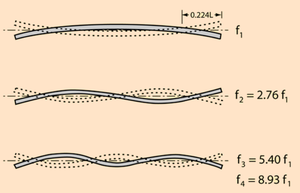Courses:PHYS341/2021/Project20
History
So far we have covered tensioned strings and vibrating columns of air, yet there is another category of instruments whose vibration is based on stiffness of bars and rods, most famous of which is the xylophone. Technically all instruments that consist of a row of bars of varied length and arranged in order of pitch and stuck with mallets can be considered a xylophone. Nowadays the term is more precisely defined as the western orchestral xylophone with bars arranged in the same way as piano keys. Yet the origin of the xylophone lies in the ancient past of Asia where the first archaeological evidence dates back to the 9th century, with written mentions of the instrument from ancient China around 2000 BCE.[1]
Bars
To understand these instruments it is first important to understand the vibration of free bars. The number of bars varies according to the instrument’s range. The average range of modern orchestra xylophones are between three (C5–C8), three and a half (F4–C8) and four octaves (C4–C8) [2]. For the vibrating bars of a xylophone, no tension needs to be applied to its bars (hence the term “free bars”, and its frequency depends on the stiffness of the bar. The free bars vibrate as shown in the first image to the right:

As we can see, the normal free bar modes are not in a harmonic sequence. Correspondingly, the pitch and timbre of the bars are tuned and enhanced through two primary approaches.
- Removing material from the middle underside of the bar to alter the overtone frequencies, and bring the second overtone closer to a harmonic frequency. By removing material from different parts of the bar it's even possible to tune single partials. [3]
- Reinforce the fundamental frequency or the first overtone with a half-open air column resonator below the bar (mentioned below)

Typical Xylophone bar shape (see second image to the right)
The reason for the bars to be shaped in this way is so that their 2nd overtone matches the frequency of the 4th harmonic. An unshaped free bar would have a natural mode f2 as 2.76 times the frequency of the fundamental.

Xylophone bars are usually made of wood or a synthetic material with similar properties. Both also have tubular resonators, (usually open at one end) below each bar. Along with the aforementioned shaping of the bars, the instrument is able to produce a harmonic timbre.
Resonator Tubes
In modern orchestra xylophones the underside of each bar is often attached to a resonator tube. These tubes serve to amplify the sound and soften the tone. The lengths of these tubes are designed to resonate at each bar’s fundamental vibration frequency.
Recall that a pipe with one open end has standing wave frequencies of f, 3f, 5f, (odd harmonics only), and these tube act the same way, amplifying the odd harmonics of the note being played.
If the pipes get shorter and longer in some xylophones/marimbas, it is purely for cosmetic purposes! (the long pipes under high notes are blocked near their tops)

Mallets
The source of energy for a bar instrument is the impact of a mallet hitting the bar. The mallet head is very briefly deformed when it strikes the bar, making contact over some area for some period of time T. Period of T is most affected by material of the mallet head, often made of rubber, wood, plastic or materials covered by yarn. Softer mallets damp the higher partials, the timbre becomes softer and rounder; hard mallets enhance the higher harmonics, brightening the timbre. The frequencies above ~2/T would have a damping effect applied to it. Striking at any point on the bar excites each natural mode proportionally to how much the mode moves at the point of contact. (A mode with a node at the strike point is not excited) The best sound comes from striking the middle of each bar, although very fast passages can be played at bar ends. The place where the bar intersects with the instrument frame is avoided. Precise rebounding of the mallets draws out more rounded tones from the bars.[4]

References
- ↑ "Vienna Symphonic Library".
- ↑ Cook, Gary D. (1997). Teaching Percussion. Belmont, California: Schirmer Books.
- ↑ "Bar Vibrational Modes".
- ↑ "How Products are Made-Xylophones".